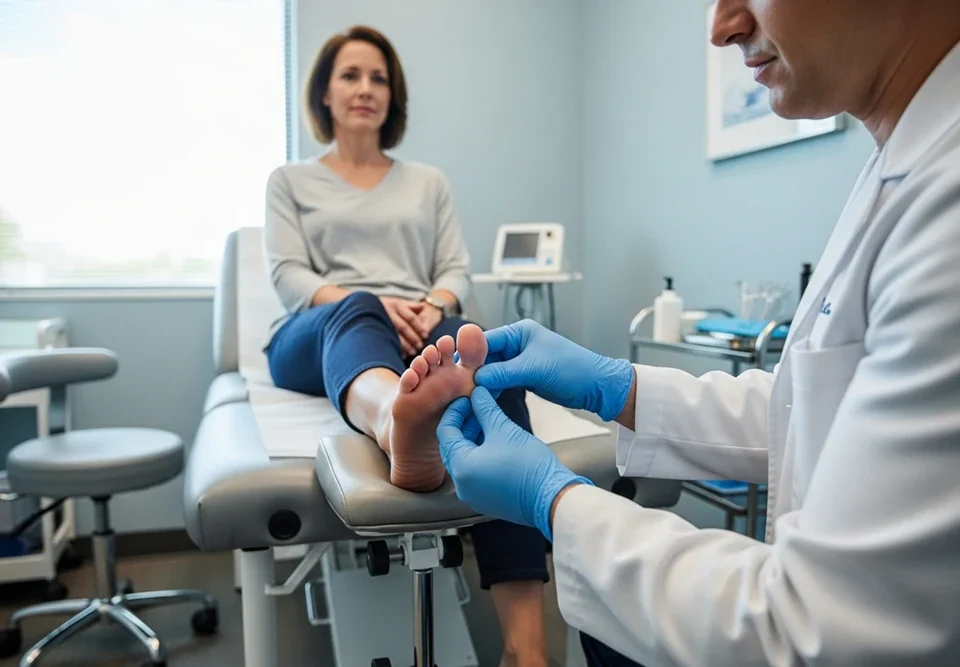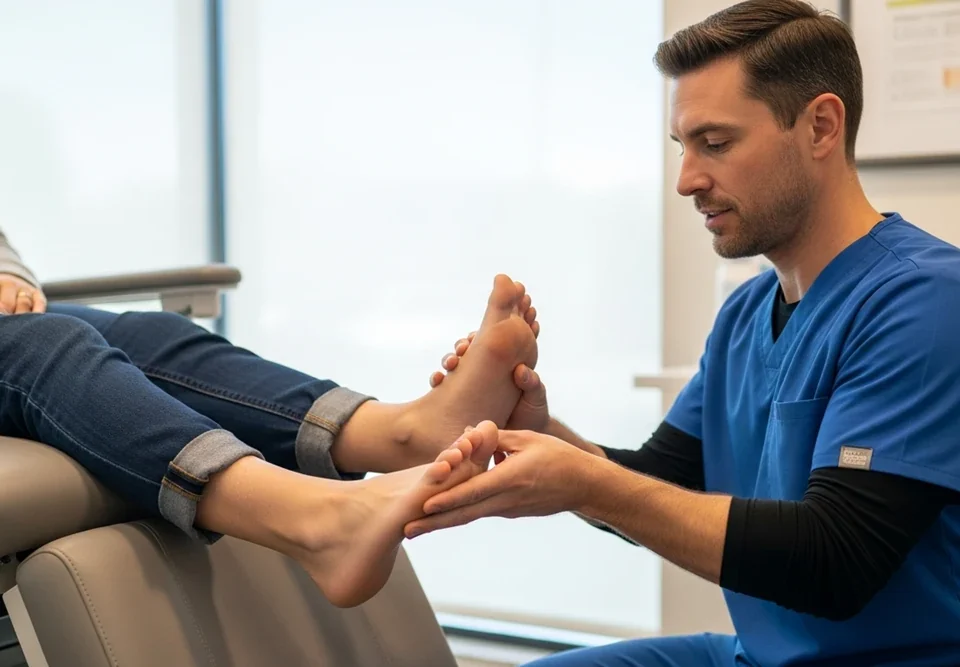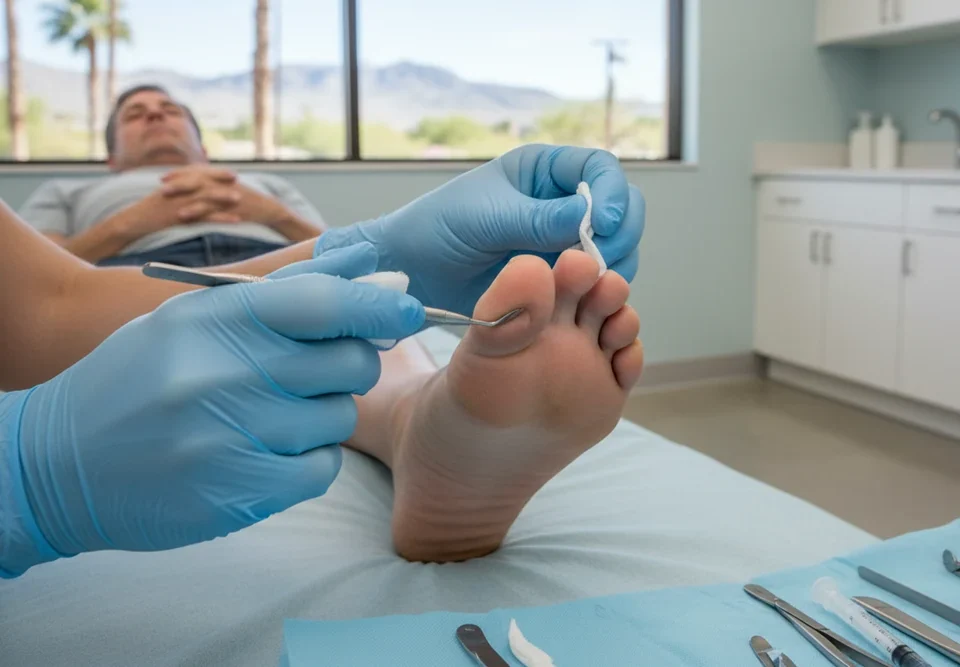
Morton’s Neuroma Surgery Cost in Phoenix, AZ
November 13, 2025
Broken Foot Surgery Cost in Phoenix, AZ
November 20, 2025Gout in foot in Phoenix can make every step painful. Gout is a type of arthritis that mostly affects the feet and ankles but can also spread to other joints over time. The good news is that with the right care and lifestyle changes, most people can control their gout and get back to moving comfortably.
Join Foot and Ankle Specialty Centers and find trusted local care in Phoenix for that swelling and burning pain in your foot or ankle.
What is Gout?
Gout is a joint inflammation that happens when uric acid builds up in the body. Uric acid forms naturally when the body breaks down substances called purines, which are found in some foods and drinks. When the level of uric acid becomes too high, it can create sharp crystals that settle in the joints. This leads to pain, swelling, and redness.
Gout in foot in Phoenix often starts in the big toe because the joint there is smaller and cooler than other parts of the body. The cooler temperature makes it easier for uric acid crystals to form. Once the crystals build up, they cause the joint to swell and feel very painful. Without proper foot and ankle treatments in Phoenix, gout can keep coming back and damage the joint.
Causes of Gout
Several things can raise the level of uric acid and cause gout in foot in Phoenix, including:
- Having too much red meat or organ meat like liver or kidney
- Eating seafood such as anchovies, sardines, shrimp, or shellfish
- Drinking alcohol, especially beer or hard liquor
- Drinking sugary sodas or sweet drinks with high-fructose corn syrup
- Being overweight or obese
- Taking certain medicines like water pills (diuretics)
- Having kidney problems that make it hard to remove uric acid
- Having high blood pressure or diabetes
- Family history of gout
- Being a man or a woman after menopause
Symptoms of Gout in Foot
| Sudden, severe pain in the big toe or foot | Swelling and tenderness in the foot joint |
| Red or warm skin around the joint | Pain that feels worse at night |
| Difficulty walking or moving the joint | The joint feels stiff and tight |
| The skin may look shiny or stretched | Repeated flare-ups in the same foot joint |
| Mild pain that lingers after the main attack | Burning feeling in the joint |
How is Gout Diagnosed?
When you visit a doctor for gout in foot in Phoenix, they start by asking about your pain, what part of the foot hurts, and how long you have had symptoms. Your Phoenix foot doctor will look closely at your foot to check for swelling and redness. They might order a blood test to measure uric acid levels or take a small sample of fluid from the joint to look for crystals under a microscope. Sometimes imaging tests like X-rays or ultrasounds help check for joint damage or crystal buildup. These steps help confirm the diagnosis so the right treatment can begin.
Treatment for Gout in Foot
Remedies for gout in foot in Phoenix focus on two things: easing the current pain and preventing it from coming back.
Pain and inflammation are treated with medicine. Pain relievers like ibuprofen or naproxen can lower pain and swelling. Some people may need prescription medicine such as colchicine, which helps stop the attack if taken early, or corticosteroids that can be taken by mouth or injected into the joint to calm inflammation quickly.
For people who have repeated gout attacks, foot doctors often prescribe medicine that lowers uric acid levels in the blood. These medicines, like allopurinol or febuxostat, help prevent new crystal formation. It is very important to take them regularly, even when you are not having a gout attack.
Lifestyle changes are a big part of managing gout in foot in Phoenix. Eating fewer foods high in purines helps lower uric acid levels. This means cutting down on red meat, organ meat, and seafood such as sardines and shellfish. Alcohol, especially beer, should be limited or avoided because it increases uric acid. Drinking lots of water every day helps flush out uric acid and keeps the body balanced. Losing weight also helps reduce pressure on the joints and lowers the chance of gout attacks.
If your foot is very swollen during a flare-up, rest it as much as possible. Elevate your foot on a pillow to help reduce swelling. Applying a cold pack several times a day (15 to 20 minutes) can bring relief. Wear soft, roomy shoes that do not press on the painful area. Some people also benefit from gentle stretching and low-impact exercise after the pain eases to keep the joints flexible.
Recovery
An attack of gout in foot in Phoenix usually improves within 3 to 10 days if treated early. The pain often peaks in the first 24 hours and then slowly gets better. If the condition is not treated, the attack can last longer, and more attacks may follow. With good care, long-term recovery focuses on preventing future flare-ups and protecting the joints from damage.
During recovery, these steps can help you heal faster and avoid future pain:
- Rest your foot and avoid walking long distances until pain improves.
- Keep your foot raised to lower swelling.
- Apply ice packs a few times each day.
- Take your medicine as your doctor prescribes.
- Drink plenty of water every day.
- Avoid foods and drinks that raise uric acid.
- Keep a healthy weight.
- Wear shoes that give support and space for your toes.
- Visit your doctor regularly to check your uric acid levels.
With time and care, most people with gout in foot in Phoenix recover well and can return to normal activities.
Where to Seek Care in Phoenix
If you have gout in foot in Phoenix, it is important to see a podiatrist or foot specialist. Contact our experienced Phoenix foot and ankle specialists for personalized, effective care.
At Foot and Ankle Specialty Centers, we offer expert diagnosis, modern treatment protocols, and tailored plans designed to relieve your pain and get you back on your feet. Call us today to schedule your appointment and start your path toward recovery.
FAQs
Where to go in Phoenix for gout treatment?
Visit Foot and Ankle Specialty Centers! We specialize in joint pain and gout. Our podiatrists can check your symptoms, treat the pain, and help you manage gout in foot in Phoenix effectively.
What’s the fastest way to flush out gout?
Drink lots of water, limit alcohol and red meat, and follow your doctor’s plan. Starting medicine early in an attack helps remove uric acid faster.
What does gout look like on the ankle?
It causes swelling, redness, warmth, and pain around the ankle joint. The skin may look shiny, and the area feels very tender.
What are the types of gout?
Gout can be acute, which comes suddenly and causes sharp pain. It can also become chronic when attacks keep happening and crystals build up over time.
How long does gout in the feet last?
A gout attack in the foot usually lasts from 3 to 10 days when treated. Without treatment, it can last longer and come back more often.




